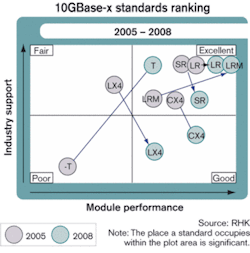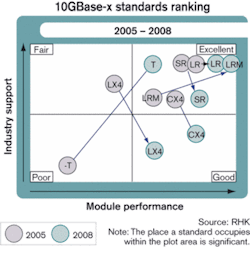10GBase-LRM and XFP win 10-GbE enterprise battles
The move by IT managers to upgrade their LANs promises to be a revenue bonanza for component vendors. Data rates are set to increase by a factor of 10, with the largest opportunity for component suppliers being 10-Gbit/sec transceivers on legacy multimode fiber over 300-m distances. In its October report, “Datacom: A Multitude of Opportunities for OC,” RHK forecasts a fivefold growth in revenue in this segment between 2005 and 2008. Yet, the growth could be limited due to the bewildering choice of standards and transceiver form factors facing equipment makers. These system vendors, struggling to understand the numerous form-factor options, must choose wisely to maximize ROIs in new line cards.* RHK also believes that the 10-Gigabit Ethernet (10-GbE) interfaces for LANs in 2005 will not prove the ultimate winners.
RHK has evaluated all the IEEE-standard options and rated them by module performance and industry support; a summary of the analysis is shown in the figure on page 38. Module performance is evaluated on a one-to-three relative point system. Factors considered include bill of materials, manufacturing challenge, module size, module reliability, and distance supported. Industry support includes system- and component-vendor support; system-vendor backing is given twice the weight of component-vendor backing. The ratings are plotted in the figure for 2005 and compared to the 2008 projection.
First, note that module performance improves for all standards. Meanwhile, industry support increases for the emerging 10GBase standards T and LRM and decreases for incumbents CX4 and LX4. Industry support is a consequence of the standard meeting evolving market requirements. The standards can be grouped into two segments: (1) requirements for 300 m that cover connections in the riser and the bulk of the market in volume and (2) requirements for up to 100 m, covering data-center and wiring-closet connections.For data links to 300 m, the options are LX4, LRM, LR. and SR. LX4 and SR are supported by IEEE 802.3ae. But since SR only meets the 300-m requirement on new multimode fiber (OM3) and deployment of this fiber, while growing aggressively, will be small compared to the FDDI installed base, it will not satisfy the majority of the market. LX4 will take the early lead in this market because it is the only viable optical solution today. However, it is only supported by Emcore, Eudyna, OpNext, and MergeOptics and has not been widely adopted by component manufacturers. In addition, products in small form factors are only just emerging and present tremendous manufacturing challenges, further limiting proliferation, since costs are too high.
LR is an elegant solution because it supports 10 km and 300 m. It is designed for singlemode operation, so it requires precision alignment. If the LRM standard is delayed or does not materialize, LR is an option-although the cost may simply be too high to experience widespread, rapid adoption.
The emerging 10GBase-LRM IEEE standard will meet the price/performance requirements and win the majority of 10-GbE ports in the LAN. While still in process, the standard currently specifies use of electronic dispersion compensation (EDC) to support 220-m transmission on worst case scenario FDDI fiber. However, whether the distance criteria should be extended to 300 m is still being debated. LRM must achieve 300 m to meet its full potential.
At shorter lengths such as data links to 100 m that cover connections in data centers and in wiring closets, other modules should find favor. The options here include SR, CX4, and T, the last two being electrical solutions.
CX4 only goes 15 m and is used with InfiniBand cable, which is heavy due to shielding; length must be specified since the cable is not field-terminated, and is expensive. CX4 also has a unique opportunity to be used in wiring closets to connect aggregation switches to edge switches. Hewlett-Packard and Cisco Systems told RHK they planned to introduce switches in the near future that would have CX4 interswitch links between wiring edge and aggregation. CX4 will also have a role in the data center, and any delay in 10GBase-T will only strengthen CX4’s position.
T is an emerging copper standard that will not be available until mid-2006 at the earliest. It is a serial 10-GbE solution that will be used with Category 5, 5e, 6, or 7 cables and will support distances of 50-100 m. These are attractive specifications, but power consumption problems must be overcome; the current level is 12-14 W and must be reduced to the industry level of 8 W.
System vendors are also struggling with XENPAK, X2, XPAK, and XFP form factors-the first three use 4 × 3.125-Gbit/sec XAUI electrical interfaces, while the fourth is serial. XFP will ultimately win in this market, but X2 and XPAK will win a considerable fraction of the ports early in the 10-Gbit/sec transition cycle.
XFP wins because it will provide the lowest-cost solution and has the small size needed for high-density line cards. XFP moves the SerDes chip out of the transceiver module and onto the board. While this adds cost for system vendors initially, the SerDes will eventually be incorporated into the ASICs, further reducing cost. XFP will succeed because most of the system vendors support this form factor. The high-power requirements of 10GBase-T will likely prolong demand for the XENPAK form factor.
Yet, the evolution of the market must be monitored through this period because XPAK and X2 are expected to win volume shipments in 2004 through 2007. Although all other switch vendors support XFP, Cisco (the enterprise switch industry leader), HP, and server suppliers support XPAK and X2. Cisco’s support of X2 certainly provides formidable competition to XFP. Furthermore, Cisco is developing futureproof line cards, with slots that accept GbE small-form-factor pluggables (SFPs) today, and two of these slots can be used for a 10-GbE X2 form-factor transceiver.
The market for X2 or XPAK will continue since this is the form factor of choice among server suppliers. Furthermore, the decisions made by Cisco and HP are stopgap measures to provide customers with solutions available today. Once the 10GBase-LRM standard is ratified and numerous credible vendors emerge, all system vendors will migrate to XFP. Given the long time frame involved, however, monitoring this evolution is prudent.
The 10GBase-LRM standard will be ratified, and vendors that can support 300 m on legacy multimode fiber stand the best chance to win market share. If product development is delayed, new passive alignment techniques will offer 10GBase-LR an opportunity to win significant 300-m multimode ports. Meanwhile, SR will dominate the data center, but T will gain strong support and grow in volumes from 2008 onward.
X2/XPAK are supported by Cisco, HP, and server suppliers and will therefore win the substantial port shipments to 2007. But once 10GBase-LRM is available, the market will quickly transition to XFP. *Companies surveyed include providers of L2 and L3 edge and core enterprise switches, such as Cisco Systems, Hewlett-Packard, Extreme, Foundry, Force10, 3Com, Enterasys, Alcatel, Nortel Networks, and Riverstone as well as server-adapter-card providers.Daryl Inniss(top) is a program director, and
Roy Rubensteinis a senior analyst at RHK (South San Francisco).


